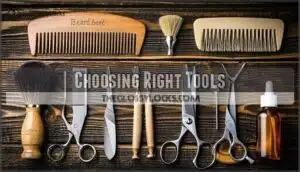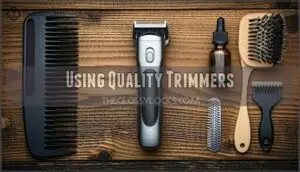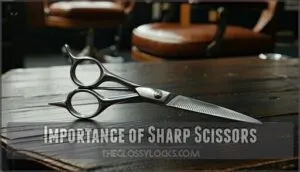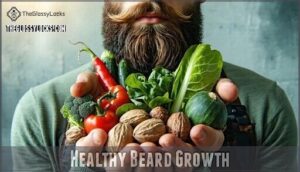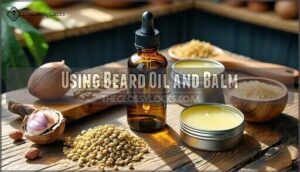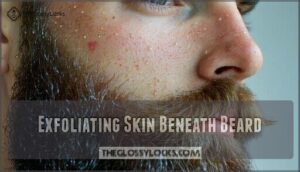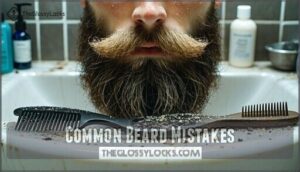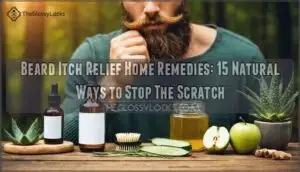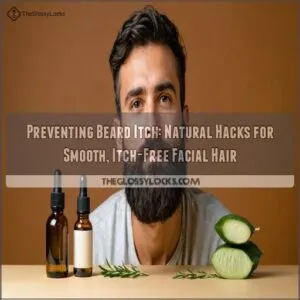This site is supported by our readers. We may earn a commission, at no cost to you, if you purchase through links.
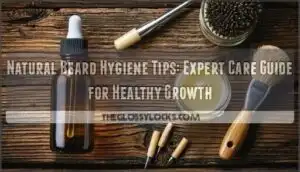
You’ll want to avoid harsh soaps that strip natural oils, leaving your facial hair brittle and itchy. After washing, pat dry and apply beard oil to moisturize both hair and skin underneath.
Brush daily with a boar bristle brush to distribute oils and prevent tangles. Don’t forget the skin beneath—it needs exfoliation and care too.
Regular trimming keeps split ends at bay while maintaining your desired shape. Your beard’s health reflects your overall grooming habits, and mastering these fundamentals sets the stage for advanced techniques that transform ordinary whiskers into remarkable facial hair, requiring proper natural beard hygiene.
Table Of Contents
- Key Takeaways
- Natural Beard Hygiene
- Beard Care Essentials
- Healthy Beard Growth
- Beard Maintenance Tips
- Common Beard Mistakes
- Frequently Asked Questions (FAQs)
- How to naturally take care of your beard?
- What is the rule 5 for beards?
- What to wash a beard with naturally?
- What is the 3 month beard rule?
- How can I clean my beard naturally?
- How do you maintain beard hygiene?
- How to manage beard odor naturally?
- Can natural remedies treat beard dandruff?
- What are eco-friendly beard care options?
- How to protect beard from pollution?
- Conclusion
Key Takeaways
- Wash gently and less frequently – Use sulfate-free shampoo 2-3 times weekly instead of daily washing to preserve your beard’s natural oils and prevent dryness
- Apply beard oil daily after showering – Use natural oils like jojoba or argan when your skin is damp for maximum absorption, focusing on both hair and skin underneath
- Invest in quality tools and maintain them – Use boar bristle brushes, wooden combs, and sharp scissors while keeping them clean to prevent bacteria buildup and ensure effective grooming
- Don’t neglect the skin beneath your beard – Exfoliate weekly with gentle scrubs and massage oils in circular motions to prevent clogged pores, dandruff, and ingrown hairs
Natural Beard Hygiene
Natural beard hygiene doesn’t require complicated routines or expensive products to keep your facial hair looking its best.
You’ll achieve healthier growth and better appearance by focusing on simple, natural approaches that work with your skin’s natural processes rather than against them, promoting natural beard care.
Washing and Cleansing
Consistency transforms your beard care routine—washing two to three times weekly with sulfate-free shampoo maintains cleanliness without stripping essential oils.
Gentle care beats harsh scrubbing—your beard thrives with consistent, natural maintenance that respects its delicate balance.
Natural beard hygiene depends on gentle techniques that work with your skin’s biology:
- Choose sulfate-free beard soap for effective beard cleansing without harsh chemicals
- Apply lukewarm water rinse to preserve natural moisture and prevent irritation
- Practice gentle scrubbing with circular motions to avoid damaging hair follicles
- Maintain proper hand hygiene before touching your beard wash routine
This washing frequency prevents the dryness that comes from overwashing while keeping your facial hair clean and healthy.
Trimming and Shaping
Precision beats power when trimming your beard.
Sharp shaping tools and a completely dry beard deliver maximum accuracy for beard trimming techniques.
Use steady, light strokes following your natural growth pattern—think sculpting, not hacking.
Define your neckline roughly two fingers above your Adam’s apple, then clean up that cheek line for crisp edges.
Don’t forget mustache maintenance; trim it before it crashes the party over your lip.
To maintain the beard’s health and appearance, consider using beard oil daily for conditioning.
Professional trims can guide your initial shaping, but regular touch-ups every 1-2 weeks keep split ends at bay.
Master these beard grooming tips and transform unruly whiskers into a beard shaping guide masterpiece.
Preventing Dryness and Irritation
Dryness turns your carefully groomed beard into sandpaper. Beard dryness and beard itch signal dehydration beneath those whiskers.
Hydration Importance becomes clear when you apply beard oil benefits post-shower—open pores absorb moisture better. Quality Product Ingredients in beard balm uses create protective barriers against Climate Effects.
Essential prevention steps:
- Apply natural beard care oils when skin’s damp for maximum absorption
- Use Gentle Cleansing weekly to remove dead cells without stripping oils
- Implement Nighttime Care routines with heavier balms for overnight repair
Your beard reflects what’s happening underneath.
Beard Care Essentials
You’ll need the right tools to maintain your beard properly and avoid damage from inferior equipment.
Quality trimmers, sharp scissors, and proper combs make the difference between a well-groomed beard and a patchy, irritated mess that’ll have you reaching for the razor.
Choosing Right Tools
Your beard grooming toolkit can make or break your daily routine. The right tools transform tedious maintenance into smooth, efficient care.
Professional results start with these five foundation pieces:
- Wooden comb – Natural wood prevents static buildup that plastic creates, reducing breakage while detangling
- Boar bristle brush – Dense bristles distribute natural oils evenly through hair while providing gentle beard exfoliation methods
- Sharp scissors – Quality steel maintains its edge longer, ensuring clean cuts that prevent split ends
- Adjustable trimmer – Multiple guard lengths handle everything from stubble to full beards with precision
- Cleaning kit – Regular tool maintenance prevents bacteria accumulation and extends equipment lifespan
Material matters substantially in beard tools. Bamboo combs offer another natural alternative that’s both sustainable and static-free.
When comparing comb vs brush functionality, combs excel at styling while brushes focus on oil distribution and skin health. Trimmer guards should click securely without wobbling, and scissor sharpness determines cut quality.
Proper tool cleaning after each use maintains your beard hygiene practices and prevents contamination.
Using Quality Trimmers
Quality trimmers make the difference between amateur grooming and professional results. When you’re ready to upgrade from basic tools, investing in a reliable trimmer transforms your beard maintenance routine completely.
Motor power determines cutting efficiency through thick, coarse hair without pulling or tugging. Higher-powered motors handle dense beards smoothly while maintaining consistent performance. Blade materials like stainless steel or ceramic offer superior durability and sharper cuts than cheaper alternatives. You can find a suitable beard trimmer online.
Smart trimmer maintenance guarantees peak performance:
- Clean blades after each session to prevent bacterial buildup and hair accumulation
- Oil moving parts monthly for smooth operation and extended lifespan
- Replace worn guards immediately to maintain precise length settings
- Store properly in protective cases to prevent damage and blade dulling
Corded vs cordless models each serve different needs. Corded trimmers deliver consistent power for lengthy grooming sessions, while cordless options provide portability and convenience. Ergonomic design reduces hand fatigue during detailed work, making precision cuts feel effortless rather than tedious.
Importance of Sharp Scissors
While sharp scissors make all the difference between amateur and professional results, dull blades tear hair fibers and create split ends.
Clean cuts from well-maintained beard scissors guarantee trimming accuracy and prevent damage. Regular tool maintenance keeps your beard hygiene routine effective.
Professional barbers know that preventing split-ends starts with quality tools that deliver professional results in beard care and beard trimming. Investing in quality beard tools is essential for achieving the best results.
Healthy Beard Growth
Your beard’s potential depends heavily on what you put on your plate. A nutrient-rich diet provides the essential building blocks your facial hair needs to grow thick, strong, and healthy.
Feed your beard from within—nutrition builds the foundation for strong, healthy facial hair growth.
Diet and Nutrition
In the context of beard nutrition, what you eat truly shapes your results.
A balanced diet is your secret weapon for healthy growth.
Here’s what matters most:
- Protein Intake: Eggs, lean meats, and legumes build sturdy hair.
- Healthy Fats: Avocados and nuts fuel hormone production.
- Omega-3s: Salmon and walnuts reduce inflammation, boosting follicle health.
- Mineral Benefits: Leafy greens and seeds fortify roots.
A diet rich in protein and vitamins can substantially impact testosterone and DHT levels.
Hydration Effects and smart Supplement Choices round out your beard-care toolkit.
Importance of Protein and Vitamins
Building on proper nutrition, your body transforms specific nutrients into beard-building blocks through targeted processes.
Think of protein sources like eggs, lean meats, and legumes as your follicle’s construction crew. These deliver amino acids that become keratin—the structural foundation of every strand. Without adequate protein-rich diet intake, your hair follicles can’t manufacture strong, resilient facial hair.
Vitamin absorption works like quality control in this biological factory. B-complex vitamins, especially biotin, regulate cellular repair and growth factors within each follicle. Meanwhile, vitamins C and E boost circulation, ensuring nutrients actually reach their destination.
Your beard nutrition strategy should prioritize beard protein sources alongside beard vitamins for maximum beard strength. When beard nutrition essentials align properly, patchy areas fill in naturally, creating the dense growth you’re after.
Role of Omega-3s and Biotin
Your beard’s potential depends heavily on what you feed it from the inside out. Omega-3s and biotin work as your facial hair’s power couple, tackling different aspects of healthy growth.
Omega-3 Benefits include reducing inflammation around follicles while boosting blood flow to nourish hair roots. These healthy fats also strengthen individual strands, making your beard less prone to breakage.
Biotin intake supports keratin synthesis—the protein that forms your beard’s foundation—directly impacting thickness and resilience.
Follicle Health improves when you combine both nutrients strategically. Inflammation Reduction from omega-3s creates an ideal growing environment, while biotin fuels the actual growth process. Biotin supplements are generally only helpful for those with a deficiency, and can be found at sources like Biotin supplements.
Focus on these Dietary Sources:
- Fatty fish like salmon and sardines for omega-3s
- Eggs and nuts for natural biotin content
- Walnuts and flaxseeds for plant-based alternatives
- Dark leafy greens for thorough beard nutrition
This nutritional foundation supports consistent beard growth while maintaining the strength your facial hair needs to thrive.
Beard Maintenance Tips
Your beard needs consistent maintenance to stay healthy and look its best.
Regular trimming, proper oil application, and skin care beneath your beard create the foundation for strong, comfortable facial hair growth.
Regular Trimming and Shaping
Your beard trimming routine every 7-10 days keeps growth manageable and your beard styles sharp.
Use quality shaping tools like sharp scissors for precision and clippers for consistent length.
Define your neckline definition two fingers above the Adam’s apple, maintaining clean cheek lines for professional trims appearance.
Focus on mustache maintenance by trimming overgrowth that covers your lip.
Proper tool care, including weekly blade replacement, helps maintain hygiene and sharpness.
Check beard symmetry frequently, making small adjustments to achieve balanced beard maintenance that enhances your natural facial structure.
Using Beard Oil and Balm
Transform your beard care routine with proper Oil Application—the cornerstone of healthy facial hair maintenance.
Beard oil provides essential moisture while balm offers styling control for longer beards.
Choose natural beard care products with quality ingredients like jojoba or argan oil.
Apply beard oil daily after showering when hair’s slightly damp for maximum absorption.
Usage Frequency matters—start with 2-3 drops, adjusting based on beard length and density.
Beard oil benefits include reduced itchiness, softer hair, and healthier skin underneath.
Combo sets provide value, convenience, and matching scent profiles for a cohesive fragrance experience.
For Scent Selection, opt for subtle fragrances that won’t overpower.
Consider these Product Ingredients essentials:
- Carrier oils: Jojoba, argan, or sweet almond oil for deep nourishment
- Essential oils: Tea tree for antibacterial properties, cedarwood for masculine scent
- Natural waxes: Beeswax in balms provides light hold without stiffness
- Vitamin E: Preserves product freshness while supporting hair health
- Shea butter: Adds conditioning benefits for coarse or wiry beards
Beard conditioning requires consistency—apply products from roots to tips, ensuring even distribution for superior results.
Exfoliating Skin Beneath Beard
While you sleep, your skin sheds thousands of dead cells that get trapped beneath your beard. Regular beard exfoliation removes this buildup, preventing beard clogged pores and creating space for healthier growth.
Product Choices matter—use gentle scrubs with sugar or oatmeal rather than harsh chemicals. Technique Matters too: massage in circular motions without aggressive pressure. Your Frequency Guide depends on skin sensitivity, but 1-2 times weekly works for most men.
Consider using a specialized beard scrub for superior results.
Circulation Improvement, oil distribution
Preventing Ingrowns, deep cleansing
beard dandruff control
Beard gentle exfoliation enhances beard skin nourishment by improving product absorption. Preventing Ingrowns becomes easier when Exfoliation Benefits include clearer follicles and reduced inflammation. Beard dead skin removal transforms your grooming routine from basic to professional-grade care.
Common Beard Mistakes
Even experienced beard growers make mistakes that can damage their facial hair and irritate their skin.
You’ll want to avoid these common pitfalls that can turn your beard care routine from helpful to harmful.
Overwashing and Stripping Oils
Your washing habits could be your beard’s worst enemy.
Overwashing strips natural beard oils, creating oil depletion that leaves facial hair brittle and skin underneath irritated. Most guys think daily washing equals better scalp health, but excessive wash frequency actually triggers product buildup and compensatory oil production. This cycle damages your beard’s natural protective barrier.
Here’s how overwashing sabotages your beard:
- Strips protective sebum that naturally conditions facial hair
- Triggers excessive dryness leading to flaking and itchiness
- Creates rebound oiliness as skin overcompensates for lost moisture
- Increases beard skin irritation from constant chemical exposure
Smart beard natural hygiene means washing 2-3 times weekly with sulfate-free cleansers. Natural alternatives like castile soap preserve your beard’s oil balance while removing dirt effectively.
Using Harsh Chemicals and Products
Commercial beard products often contain synthetic ingredients like sulfates and phthalates that cause chemical irritation and product allergies.
These harsh chemicals strip your beard’s natural oils, leading to dryness and brittle hair. Formaldehyde releasers and mineral oils clog pores, promoting dandruff and skin problems.
Damage prevention starts with reading labels carefully. Choose natural alternatives like sulfate-free shampoos and organic oils instead.
Natural products with jojoba and argan oil support natural beard hygiene while providing effective irritation prevention for healthier beard skin care. Some products contain ingredients that can disrupt endocrine function.
Neglecting Skin Beneath The Beard
Your beard’s foundation matters just as much as what’s visible above.
Hidden skin issues like clogged pores and dead cell buildup create a breeding ground for irritation and poor follicle health.
Many guys focus on beard care while completely neglecting the skin underneath.
The skin beneath needs attention for natural beard hygiene:
- Weekly exfoliation prevents dandruff and removes buildup that blocks healthy growth
- Daily beard oil massage nourishes follicles and prevents painful ingrown hairs
- Gentle circular motions boost circulation and support beard natural remedies for stronger growth
Proper beard skin care transforms your entire grooming routine from the ground up.
Frequently Asked Questions (FAQs)
How to naturally take care of your beard?
Caring for your beard naturally starts with washing 2-3 times weekly using sulfate-free shampoo or natural castile soap.
Apply jojoba oil daily, brush with boar bristles, and eat protein-rich foods for healthy growth.
What is the rule 5 for beards?
You might think "Rule 5" is official beard doctrine, but there’s no universal "Rule 5" for beards.
However, a common fifth principle is: replace razor blades every 5-7 shaves to maintain sharpness and prevent irritation.
What to wash a beard with naturally?
You can wash your beard naturally with castile soap mixed with carrier oils like jojoba or sweet almond oil.
Add distilled water and optional essential oils for fragrance and skin benefits.
What is the 3 month beard rule?
Give yourself 90 minutes to hang out without trimming or shaping.
Resist the urge to reach for that razor, no matter how patchy or awkward things look during those first pivotal months.
How can I clean my beard naturally?
Use homemade beard wash with castile soap, jojoba oil, and distilled water.
Wash 2-3 times weekly with lukewarm water using gentle circular motions.
This preserves natural oils while removing dirt effectively.
How do you maintain beard hygiene?
Clean, brush, trim: three pillars of proper beard maintenance.
You’ll want to wash 2-3 times weekly with sulfate-free cleanser, brush daily to distribute natural oils.
And trim every 1-2 weeks to prevent split ends, which is a complete concept in beard care.
How to manage beard odor naturally?
Bad smells happen when bacteria feast on trapped food particles and dead skin.
Regular washing with sulfate-free beard shampoo 2-3 times weekly removes buildup naturally.
Daily brushing distributes oils and prevents odor-causing accumulation.
Can natural remedies treat beard dandruff?
Natural oils and gentle ingredients can effectively tackle beard dandruff.
Regular exfoliation, moisturizing with jojoba oil, and using tea tree oil help eliminate flakes while soothing irritated skin underneath your beard.
What are eco-friendly beard care options?
Eco-friendly beard care focuses on sustainable products and practices.
You’ll find biodegradable beard washes, organic oils, bamboo combs, and plastic-free packaging.
Homemade solutions using natural ingredients like castile soap reduce environmental impact substantially.
How to protect beard from pollution?
Your beard’s like a filter catching urban grime daily.
Wash with gentle, sulfate-free cleanser twice weekly, apply protective beard oil or balm before heading out.
Brush nightly to remove accumulated pollutants and debris.
Conclusion
Mastering these natural beard hygiene tips isn’t rocket science—unlike those medieval barbers who doubled as surgeons.
You’ve learned that consistent washing, proper oiling, daily brushing, and regular trimming form the foundation of exceptional beard care.
Remember, your skin beneath needs attention too, so don’t skip the exfoliation.
Quality tools make a real difference, while proper nutrition supports growth from within.
Avoid overwashing and harsh chemicals that’ll damage your progress. Start implementing these natural beard hygiene tips today, and you’ll notice healthier, more manageable facial hair within weeks.
- https://www.independent.co.uk/life-style/fashion/skin-skin-conditions-black-cheltenham-b2142259.html
- https://www.mankindbarbersnyc.com/blog/miscellaneous/dont-sabotage-your-beard-the-top-5-common-mistakes-that-can-damage-your-facial-hair
- https://www.scotchporter.com/blogs/news/beard-care-guide
- https://trilogylaboratories.com/benefits-of-beard-oil-and-balm/
- https://www.youtube.com/watch?v=qYPbbgQcwRs

